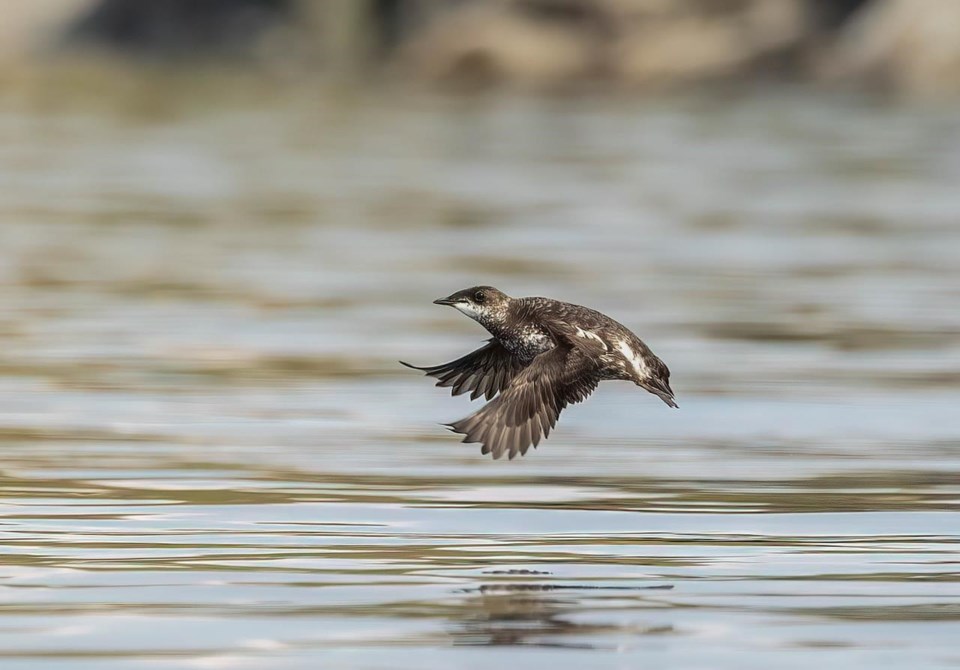It is only a little bird, weighing a few ounces, but the marbled murrelet is known for its remarkable ability to fly far out to sea to catch fish before returning in the darkness of night to inland treetop nests on mossy limbs.
It also inspires outsized devotion among those who want to study and protect it.
Royann Petrell of Courtenay on Vancouver Island has been an avid bird watcher since childhood, but in retirement she has taken up the cause of protecting the marbled murrelet's habitat.
The seabird has been listed as "threatened" for decades as habitat loss on both sides of the Canada-U.S. border adds to its precarious existence.
Petrell's birding activities have even landed her in court, fighting a logging company that put up gates in the contentious Fairy Creek area where protests over old-growth logging landed hundreds in handcuffs.
Petrell, who’s a retired associate professor at the University of B.C. in the faculty of applied science, claimed the gates prevented her from collecting data on the murrelet and its habitat.
The data, she said, is crucial to her proposal for the provincial government to create additional wildlife habitat areas to protect the murrelets' nesting grounds because continued logging will mean the bird's eventual loss.
"The forestry company said in its own forestry management plan that the forest will be gone in 15 years. They will cut it all down except for these few wildlife habitat areas," Petrell said. "It's not going to last. It's not sustainable."
In the last two decades, Petrell and her fellow birders calculated that a quarter of the murrelet's prime nesting habitat has been lost in what's known as Tree Farm License area 46, currently held by the Teal Jones Group.
Petrell belongs to The Old Growth Birders and BioBlitzers, a group of citizen scientists who have proposed to the provincial government the creation of more protected areas for the birds in Fairy Creek. Petrell said the group found discrepancies in government pledges to protect habitat versus the actual amount of land set aside.
In a December 2022 letter to the province, Petrell urged the creation of new designated habit areas that "will protect two of the best remaining sizable remnants of B.C.’s old-growth forests on Vancouver Island."
In a response letter from the Ministry of Water, Land and Resource Stewardship, the provincial government thanked Petrell for her efforts.
"We welcome the public’s constructive identification of potential areas for a WHA (wildlife habitat area) and as noted regional staff will review the proposal," an April 2023 response letter said.
Her work has since received endorsement from researchers in the United States, who are urging Premier David Eby to adopt the proposal.
Martin Raphael, a retired U.S. Forest Service research scientist in Washington state, said protecting marbled murrelet habitat is crucial to the species' survival.
Raphael's work goes back decades, documenting the bird's migration from the U.S. to nesting areas in the Fairy Creek watershed using radio tags to track the bird's long flights out to sea back to inland nesting grounds.
"Protection of nesting habitat is really the key driver in trying to recover the species, and so when this proposal came along to try to conserve habitat, protect it from logging and other losses, I knew that would be important," he said.
Raphael had never seen a marbled murrelet before he began researching and surveying the birds in the 1990s, but they eventually became the focus of his work for 20 years.
His fascination grew, he said, out of admiration for how they fly far out to sea to forage for fish "and find the exact limb on a tree in the middle of the forest that it's nesting on."
"The fact that they do that at night when there's no visibility, it just amazes me," he said.
In Washington state, the birds' habitat enjoys federal protection on public lands, but private forest lands are still fair game for logging, leading to habitat loss and population decline, he said.
For Petrell, her love of bird watching stems from her mother's sadness after the loss of her father when Petrell was just two years old.
"The one thing that made her happy was bird watching," she said.
One excursion stands out for Petrell, when she and a group of fellow birders were awoken early one morning by the shrieking calls of murrelets flying above their tents.
Recent research, she said, indicates the birds communicate about suitable nesting areas as they make their way back to their forested homes.
"We were just totally blown away," she said. "You hear them flying right over your tent, up the watershed, right into the forest, and that's the same forest that we would like to make sure that it turns into a wildlife habitat area."
This report by The Canadian Press was first published July 23, 2023.
Darryl Greer, The Canadian Press

